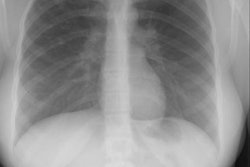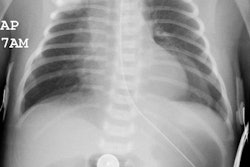Pulmonary interstitial emphysema
Clinical:
Rupture at the bronchoalveolar junctions associated with
mechanical ventilation allows the passage of air into the
perivascular and peribronchial spaces which results in pulmonary
interstitial emphysema [1]. Once PIE is established, air may
dissect along the bronchovascular sheaths or lymphatic channels to
form subpleural blebs [1]. These subpleural blebs can rupture and
produce pneumpthorax [1]. Air can also dissect and produce
pneumpmediastinum. pneumopericardium, or pneumoperitoneum [1,2].
The condition is typically bilateral, but can be unilateral or
confined to one lobe [2]. PIE usually occurs in the first week of
life, whereas BPD tends to produce lucencies that slowly evolve
over the first 3-4 weeks [2].
X-ray:
On CXR, acute PIE appears as multiple bubbly tubular/nonbranching
and cystic lucencies that fail to conform to the predictable
branching pattern of air bronchograms [1].
REFERENCES:
(1) Radiographics 2005; Agrons G, et al. Lung disease in
premature neonates: radiologic-pathologic correlation. 25:
1047-1073
(2) AJR 2018; Liszewski MC, Lee EY. Neonatal lung disorders: pattern re to diagnosis. 210: 964-975




